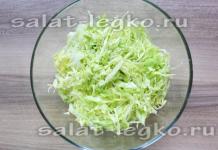Culture bonsai originated in China and Japan.
Translated from Japanese, “bon-sai” (the Chinese word is “pun-sai”) means “wood in a bowl.”
However, a bonsai is not just a container tree, it is a true work of art that requires many years of work. In the eastern tradition, bonsai-style trees are classic elements of interior and landscape design.
Bonsai is a whole language of symbols. Some of the miniature trees resemble the inhabitants of sea coasts, bent under cruel winds, others are alpine plants, fancifully hanging branches from the rocks, while others, on the contrary, look serene and simple - like a meadow tree located in the middle of a sunny island of tranquility.
In nature, the shape of a tree is formed under the influence of wind, sun and relief, and a bonsai master imitates natural forms with his own hands - using a knife, pruning shears and wire guides.
|
– the age of the tree is about 20 years. The shape of the tree is not ideal - after all, this bonsai was formed by a beginner amateur. |
This miniature linden 30 years. This very beautiful bonsai, made by the German Dieter Arndt, has already repeatedly won prizes at various exhibitions. |
A classic bonsai is a miniature copy of a life-size tree on a scale of 1:100.
In Japan, they believe that a pine tree looks like an old man, and a deciduous tree looks like a young girl. Therefore, miniature pines and junipers are usually planted in rough, irregularly shaped bowls made of wood or stone. Deciduous bonsai are placed in elegant ceramic vessels.
Bonsai have been grown for decades. And the older and more beautiful the bonsai becomes, the more expensive bowls it is transplanted into, emphasizing the nobility of the composition. In Japan, these bowls are custom-made by hand so that the vessel perfectly complements the bonsai artist's design.
Making a bonsai yourself is very difficult and time-consuming, but also exciting. Let's look at the stages of growing a bonsai tree.
 | Choosing a blank tree for bonsai First you need to choose a plant - it is best to take not a street specimen, but a young plant that originally lived in a container and is already adapted to such conditions. You can also grow a seedling specifically for creating a bonsai - but this will take longer. The roots of a young plant are shortened and planted in a flat bowl. The initial bowl is taken as simple as possible, undecorated. |
 | Trimming the top of a tree In spring, the top and side shoots of the tree are cut off. After this, the tree begins to gain trunk thickness, but its height will remain small. It is better for the plant to spend the summer outside, but for the winter, bonsai are placed in frost-free rooms - their roots are not adapted to frost. |
 | Regular pruning of branches and roots In subsequent months and years, pruning is repeated many times. Branches, especially thick ones, should be trimmed very carefully. For pruning, you should purchase a special pruner with a concave blade and ensure that its blades are sharp. Pruning with such pruning shears causes minimal damage to the tree - the cut areas heal faster. Every year, the future bonsai should be removed from the bowl and its roots trimmed. |
 | Buds for growing crowns When the trunk of the required thickness is formed, several buds are left on the tree for the development of branches. From this moment, work begins on the shape of the bonsai crown. |
 | Main branches for the bonsai crown skeleton You need to wait until the branches form. After this, several branches are left in the bonsai for further crown formation, and the rest are cut off. |
 | Shaping bonsai branches To give shape to bonsai branches, wire - aluminum or copper - is used. The thickness of the wire should approximately correspond to the thickness of the branches. The wire is carefully wrapped around the trunk and branches of the tree, giving them the desired direction. For opposite branches use one piece of wire. The tips of the branches are pinched to improve branching. |
 | Regular formative pruning of branches Next comes the most interesting part. The tree will gradually grow in the direction that the wire sets it. Adjust the wire as you watch the bonsai grow. Regularly trim young shoots to help the tree branch better and remain compact. |
 | Transplanting a bonsai into a decorative bowl When the bonsai is ready, you will need to select the appropriate bowl for it and think through the entire arrangement. |
Photos of bonsai trees
|
If a bonsai is made from a fruit tree or shrub, then it continues to bloom and bear fruit at the usual time for its kind - like hawthorn in this photo. |
This maple for more than 80 years! A multi-tiered crown has been formed on the tree by the skillful hand of a bonsai master. There is a deep bowl under this bonsai, since the height of the vessel should be proportional to the diameter of the crown. |
|
Bonsai from juniper, the crown of which is formed by a semi-cascade. An irregularly shaped bowl was selected from the tree, which imitates a depression in a rocky slope. |
|
|
Bonsai trees should be advantageously positioned on stands and well lit - so that a garden visitor can admire them first from afar, and then, coming closer, examine their filigree crown. |
|
|
Oriental style gardens are often decorated with bonsai. Typical of a Japanese garden is a red bridge, stone lanterns, miniature trees and giant grasses - sedges, bamboo and others. However, if you follow this example and decorate your garden with miniature trees in the summer, do not forget to protect them from frost in winter and autumn. The specificity of the root system of bonsai does not allow it to winter outside in mid-latitudes. |
|
Bonsai is the art of creating exact replicas of dwarf trees. It first appeared in China when a certain eighth-century emperor issued a decree to create a miniature of the entire Chinese empire with all its natural elements. Buddhists believed that a person who grows bonsai becomes equal to God. The first exhibition of dwarf trees was held only in the 19th century in Tokyo. Currently, there are many types and techniques for growing bonsai, described on the pages of more than 1,200 books and translated into 26 languages.
Variety of species and growing techniques
There are two techniques for growing miniature trees:
- Traditional.
- Special.
Traditional techniques are divided into the following styles:

The special technique is less popular than the traditional one. Basically, only gardeners who are “in love with the business” use it.
Styles of this technique:
- Landscape in miniature.
- Growing on a rock.
- Forest form.
- Growing in the wind.
- Common roots.
The full variety of bonsai species is impossible to list. Let's look at the most popular of them:

Growing lemon at home
Indoor (dwarf, bonsai) lemon is a perennial evergreen tree with sour fruits from the rue or citrus family. The height of the plant usually does not exceed 1.5 meters, with the exception of tall varieties. Lemon bears fruit for about 60 years, and the formation of fruits from flowering takes up to 8 months.
The following varieties are ideal for growing plants on a windowsill:
- "Ponderosa";
- "Novogruzinsky";
- "Pavlovsky";
- "Meyer".
It is important to remember that lemon does not tolerate direct sunlight. That is why the best place for it will be the western side of the room. In addition, this tree cannot be moved much. To ensure uniformity of the crown, it is only slightly turned over (about 2 cm) once a week.
Bonsai needs to be constantly cared for at home so that it bears fruit regularly and does not lose its longevity.
Step-by-step landing instructions:

Boxwood at home
 Boxwood is an evergreen shrub with iridescent leaves. This is a long-lived type of bonsai, living up to 500 years.
Boxwood is an evergreen shrub with iridescent leaves. This is a long-lived type of bonsai, living up to 500 years.
Its wood is dense, its leaves are leathery, its flowers are small and pleasantly smelling, and its fruits are capsules that crack when ripe and scatter black seeds.
Boxwood propagates by seeds and vegetative methods.
Boxwood bonsai - how to grow for novice gardeners step by step:

Scots pine bonsai
Pine is the most unpretentious tree for growing bonsai. In the Japanese garden this is the most popular type of dwarf tree.
Over the entire period of the art of growing miniatures, the following pine bonsai have been created:

Growing a bonsai from Scots pine with your own hands is quite simple if you follow a number of simple rules:

Dwarf oak from acorn
Oak is a massive, strong tree from the beech family. In China, it is a symbol of immortality and longevity.
Instructions on how to make a massive and miniature oak bonsai at home:
- We select acorns that are free from damage and pests.
- We lower them into a container of water and sift out those that float - such acorns are unsuitable for planting.
- How many specimens have settled - so many need to be dried and placed in a plastic bag with moss before germination (for about 2 months).
- We plant the sprouts in a pot with a diameter of no more than 5 cm.
- You need to make holes at the bottom of the pot to get rid of excess moisture.
- In the future, the size of the pot should be increased to a diameter of 25 cm.
- The formation of a trunk type with wire begins when the height of the tree reaches 30 cm.
Plant care
The beauty and health of bonsai oak directly depends from proper care of it.
Bonsai - how to care at home:
- It is important to maintain favorable climatic conditions: a warm room with moderate humidity and good sunlight.
- Selecting soil for replanting: It is best to plant the plant in airtight clay.
- An adult plant should not recharge often, since the appearance of the bonsai will be spoiled by the appearance of large leaves.
- Advice: in order to emphasize the elegance of the wood, you should choose a die that contains blue and brown colors.




Bonsai is the ancient Japanese art of creating miniature trees and shrubs. It is important to understand that this does not mean some special varieties of these plants, but a special technology for growing familiar large forms. It follows from this that growing bonsai yourself at home is quite difficult and troublesome. The first results of your work can be seen no earlier than 5 years after planting. The most common way is to use low seedlings 15-20 cm.
Show all
Plant selection
Theoretically, absolutely any plant is suitable for creating a miniature form. When choosing, you need to start first of all from the living conditions that a person is able to provide at home. If the room is always hot, you can pay attention to tropical trees.
The next criterion is beauty. This concept is very subjective, so the options can be very different. You can choose your favorite plant as the basis for a bonsai, or try to grow something from the classic trees of China or Japan, such as the famous pink sakura.
There are plants bred specifically for growing as bonsai. For example, maples with multi-colored leaves: blue, light blue, red and purple.
Bonsai blue maple
- pine;
- maple;
- birch;
- lilac;
- Linden;
- larch and others.
These trees and shrubs are accustomed to the local climate, which will greatly facilitate the process of growing them.

Where can I get planting material?
There are several options, depending on which plant is chosen:
- Seeds of a wide variety of trees and shrubs are sold in flower and garden stores. There you can also find some seedlings and even cuttings. The seedling can also be purchased at a special nursery. As a rule, they also sell exotic species.
- If the plant is local, then you can dig up a seedling you like in the nearest forest or park. There, if you try, you can find seeds or cut cuttings.
- Planting material can be taken from your own garden or cottage (if available).

Types of tree shapes
The next important step that needs to be thought through in advance is composition. It is in accordance with it that the further formation of the tree will take place. In addition, the choice of pot and planting method depends on the composition.
There are a number of classic styles in bonsai, from which you can create something new and unique.
Thus, the straight symmetrical style has an even vertical trunk and horizontal branches diverging from it in all directions. The crown looks smooth and neat.

Straight symmetrical style
In the straight asymmetrical style, the trunk is vertical but curved. The branches are located in places of bends on the convex side.

Cascading bonsai has a strongly arched trunk that extends below the bottom of the pot.

The half-cascade looks almost the same as the previous style. The difference is that the trunk does not fall below the bottom of the pot.

In an inclined bonsai, the trunk is straight or slightly curved and clearly inclined to one side.

A weeping bonsai has a vertical trunk, and the branches bend and fall down.

Double - one tree with two trunks united near the roots. Often one of the trunks is smaller than the other.

“Tree in the wind” - the trunk is strongly inclined to one side, and all the branches of the bonsai are directed in the same direction.

A group of trees is several plants gathered together.

Bonsais growing on stones that replace a pot can also be called a unique style. Trees in such compositions grow directly from cracks in the stone filled with soil mixture.


Optimal sizes
Bonsai trees differ from each other not only in shape, but also in size. The smallest of them can have a height of only 8–10 cm, the largest - up to 1.5 meters. The size does not depend on the age of the tree, but everything is laid at the same stage of thinking through the shape.
The main criterion is the size of the leaves or needles. If they are small, then the size is determined only by the personal taste of the owner. But with larger ones, it is necessary to determine the minimum height at which the tree will look harmonious and proportional. The following table shows the minimum bonsai sizes for some tree species:
Suitable pot
A bonsai pot must have a number of features so that the tree can grow comfortably in it, and the owner can carry out all the necessary procedures, such as pruning the roots. Therefore the correct capacity should be:
- quite small (but consistent with the selected tree size);
- without glaze on the inside;
- with large drainage holes (about twice as large as regular pots).
And bonsai is still an art. Therefore, the pot should look beautiful and be in harmony with the intended composition.
Soil selection
Soil plays an important role in growing bonsai. The main requirements for it are as follows:
- the soil should be quite rough;
- easily absorb moisture;
- hold liquid for a long time.
The easiest way is to buy a ready-made soil mixture specifically for bonsai. As a rule, it consists of sand and some kind of organic soil (peat or humus), taken in a 1:1 ratio. Some manufacturers add a little clay to such soil.
Based on the characteristics of the selected plant, you can try to create your own soil mixture that is optimally suited for a specific tree. However, to do this you need to have knowledge and experience in gardening.
Planting and care
Caring for a bonsai tree largely depends on the type of plant from which it is grown. But there are also universal rules:
- Any tree needs regular watering and fertilization with certain substances. However, during the first year of life, the seedlings do not need to be fed - the soil still has enough nutrients.
- Plants for which the local climate is natural can be taken out to the balcony in winter and placed on a sunny windowsill in summer. The rest of the time, it is necessary to avoid both direct sunlight and hypothermia.
- To slow down growth, the bark on the trunk is cut horizontally in several places. It is important not to cut it along the entire circumference of the stem, otherwise the plant will die.
- Any bonsai needs to be replanted regularly. For each specific type, the terms are different, the maximum is once every 2 years. When replanting, excess roots are cut off from the tree, after which the plant is returned to the same pot.
Saplings
The easiest way to grow bonsai is from a medium-sized seedling 15–20 cm high. It is recommended to be used by beginners in this business. But it leaves the least room for creativity and transformation of the tree. The seedling must be taken from its home along with the soil and grown in it for the first time. It is best to do this in early autumn.
Step by step guide:
- 1. Using scissors, trim the roots to a length of 7–10 cm.
- 2. Trim all branches except those that are strictly horizontal.
- 3. Place a layer of expanded clay at the bottom of a wide but shallow container.
- 4. Pour a small amount of a mixture of base soil (in which the bonsai will grow) and soil familiar to the seedling. Ratio - 1:3.
- 5. Plant a seedling.
- 6. Sprinkle with the same earthen mixture.
- 7. Water.
- 8. Take it out into the fresh air (on the balcony).
There the plant should stand through winter and spring. At the beginning of summer, it can be moved indoors and transplanted into a permanent pot with basic soil.
Seeds
Growing bonsai from seeds is the longest and most difficult way. The results of its use in some cases can be seen only after 10–15 years. But sometimes the desired appearance of a tree can only be achieved with its help.
When growing bonsai from seeds, you can give it absolutely any desired shape. For example, to create a strictly vertical tree, it is necessary to prune the branches and roots from the first year of life. It is also easier to bend trunks during this period.
Some varieties of seeds must be specially treated before planting. Some of them require freezing, others simply need to be stored for some time in a cool or warm place. Specific actions depend on the type of plant chosen.
After such specific processing, if it was needed, the algorithm of actions for all seeds will be the same:
- 1. They are placed in water or damp sphagnum for several days.
- 2. Then they are taken out and treated with an antifungal drug.
- 3. Peat pots are filled two-thirds with a mixture of sand and peat.
- 4. Prepared seeds are placed on top of the soil.
- 5. The next layer is sand, its thickness is no more than two diameters of the seeds being planted.
- 6. Next, water the seedlings.
- 7. The pots are covered with glass, a plastic lid or polyethylene.
The resulting mini-greenhouse is placed in a shaded place where the temperature is maintained at no more than 15 degrees. During seed germination, you need to carefully monitor the soil moisture and water it as needed.
When the first shoots appear, it is necessary to provide the crops with a constant flow of fresh air. To do this, a sliver is placed under the glass or lid on one side, and several holes are made in the film. When the first leaves appear, the protection that covered the pots can be removed.
At the age of 2–3 months, the seedlings undergo the first pruning of the tap root. It is shortened by approximately two-thirds of its length. After this, it is advisable to treat the cut site with a growth-enhancing drug to reduce the likelihood of plant death.
When the sprouts reach a height of 10 cm, they can be transplanted into permanent containers and transferred to the main place of detention.
Cuttings
Many plants can be propagated using cuttings. This method is also suitable for growing bonsai.
A cutting is a part of a plant branch that, when planted in the soil, takes root if properly cared for. For deciduous plants they are harvested in June, for conifers - in April or at the very beginning of September. Before planting, you can treat the cut areas with special growth enhancers.
Low plastic pots or containers are suitable as containers for planting. Soil (usually a mixture of peat and sand) is poured into them to two-thirds of the height, after which cuttings are stuck into it at an equal distance from each other and watered. Next, it is advisable to cover the seedlings on top with a transparent plastic lid, creating a kind of mini-greenhouse. This entire structure is located in a shaded area. Every day you need to check how wet the soil is in the container or pot with seedlings and water as needed.
You can cover the planted cuttings with a microwave lid or use plastic wrap for this purpose.
After some time, leaves will begin to form on the cuttings. This takes from two weeks to a month; the exact period depends on the type of plant. From now on, it will be necessary to lift the lid every day for an hour or two so that the plants are ventilated and get used to normal living conditions.
After a few months, you can transplant the trees into their permanent pots with a basic potting mix. The specific period depends on the type of tree. For coniferous species it can last up to a year.
Bonsai formation
A distinctive feature of bonsai is not only its miniature size. Each such tree has some kind of design. Most often this is an imitation of some natural state of the plant. It is achieved through special technologies, such as:
- pruning;
- topping;
- figured cutting;
- wire wrapping.
The art of creating miniature tree replicas is valued at making them look as natural as possible. Therefore, to get inspiration in this area, you need to pay attention to trees growing in natural conditions. Particularly interesting will be old specimens and those plants that have been exposed to adverse weather conditions - for example, split by lightning.
Trimming
This is the main and main way to form a bonsai. It exists in two types:
- maintaining the existing form;
- structural - it is this type of pruning that creates a new shape for the plant.
To prune correctly, you need to understand exactly how trees grow. The very top of the trunks and the tips of the branches are responsible for growth. Because of this, the upper branches grow better, and the lower ones grow worse. In older trees, the latter die off. To prevent this from happening, the upper parts of trunks and branches are usually pruned. In this case, growth begins to go not upward, but to the sides. Such pruning must be done regularly.
Pruning shoots of deciduous trees is done using bonsai scissors or pruning shears. It is advisable to carefully tear off conifers with your hands, otherwise the cut ends will begin to deteriorate. As part of maintenance pruning, you need to periodically trim branches that become too long and begin to stray from the originally intended crown shape.
Pruning also includes the complete removal of leaves from a tree in the summer. As a result, new ones begin to grow smaller and more branches appear.
Structural pruning of a bonsai is a more complex procedure. During it, the branches are not just trimmed, but completely removed. This pruning should be done either in early spring or late autumn, depending on the type of plant.
All dead branches must be cut off first if they are not part of the concept. Next, inspect the plant and identify those branches that do not fit into the intended shape. They also need to be pruned. In the process, it is advisable to be guided by some principles of bonsai formation (if they do not contradict a specific plan):
- one of the two branches located at the same height is removed;
- unnaturally curved branches are trimmed, as well as vertical ones that cannot be bent;
- branches that cover the front lower part of the trunk are removed;
- branches that are too thick at the top are removed (principle: the lower branches are always thicker than the upper ones).
Removing thick branches may leave large, unsightly marks on the trunk. Damage can be reduced by performing the operation with concave pliers. And specialized stores sell ointments that promote rapid healing of scars and protect the tree from infection.
Working with wire
The main point of forming a bonsai using wire is that the branch or trunk is bent into the required position and fixed. The plant remains in this state for 3-4 months, after which the fasteners are removed. The branch that has “remembered” the desired position continues to grow as it should.
Regular and floral wires are not suitable for this type of work because they quickly rust and do not have sufficient flexibility. But in specialized stores you can find wire directly for bonsai.
The formation technology is as follows:
- first, the wire is wrapped around the barrel a couple of times to secure it;
- then the branch is carefully wrapped and then bent into the desired position.
It is necessary to act extremely carefully so as not to break or damage the plant. If correction of the shape of the entire tree is necessary, the trunk is wrapped first, then the large branches, and the small ones last.
It is important to remove the wire in time, not allowing it to grow into the bark, otherwise unsightly marks will remain on the tree. Under no circumstances should you unwind it, otherwise there is a risk of damaging the plant. Instead, you need to cut it with wire cutters at each turn.
A few important rules:
- the wire should lie on the plant at an angle of 45 degrees;
- the thickness of the wire should be about a third of the thickness of the branch itself;
- if the cut piece of wire was not enough for the branch, you can continue to wrap it with another piece, trying to do it close to the first and parallel to it;
- when bending a branch downwards, the wire is fixed on the trunk below this branch, and when bending upwards, above it;
- When using thick wire, it is advisable to place some soft protective material under it, such as a piece of leather.
In addition to winding, wire can be used to create guy ropes. This method is suitable if you need to bend down a thick branch or an entire trunk. To do this, you need to cut a piece of wire slightly longer than the distance from the desired position of the branch to the attachment point. One end of the rod is attached to the wall of the pot or to the soil inside it, the second is wrapped around a bent branch.
Branch guy
Creating the effect of an old tree
Among bonsai lovers, specimens that look like old perennial trees are popular. In this regard, certain technologies have been invented that make it possible to artificially age a plant. They are quite difficult to master, so some experts recommend first practicing on cut tree branches and only after achieving the desired result with them, start working with bonsai.

Aged bonsai
There are three main ways to make wood look old:
- bark cutting;
- trunk splitting;
- figure cutting.
The bark is removed using pliers or a knife. If the tree is to remain alive, you should never cut off all of its bark, since this is where nutrients pass through. It is necessary to leave several continuous thin strips running from the root to the top of the trunk and from the trunk to the end of each branch. The same should be done when aging individual branches. But if dead trees or branches are imitated, the bark is completely removed from them. After which the bonsai or a separate section of it can be processed with a wood cutting knife. This way you can give the plant the desired shape and identify any defects or damage.

Simulation of dead trees in the forest
The tree trunk can be split using wire cutters or thin pliers and wedges. You can also use a wood knife to cut holes in the middle of the trunk. They can imitate hollows or traces of lightning strikes.

Imitation of a tree damaged by lightning
How to grow a bonsai in a few months
There is a way to grow a cute little tree in just a few months. Of course, it will not be a bonsai in the traditional sense of the word, but the external resemblance will still be noticeable.
Step-by-step instruction:
- You need to take several ivy sprouts and plant them in one pot as close to each other as possible.
- When they grow to the desired size (but not more than 20 cm), you need to start pinching the tops and trim off most of the side shoots.
- As they grow, the stems will become woody and intertwined. The result will be a small tree.
Not everyone can grow bonsai correctly at home, because this is a real art that requires creativity and special skill from a person.
As you know, bonsai is a copy of an ordinary tree, but only in smaller sizes. Such plants are very often used to create a unique and original interior in a home or office space. Before growing a bonsai, you will need to spend a lot of time studying special literature on planting techniques and further care.
In order to create such a piece of art at home, you need to take care in advance of having the following tools and working materials:
- special ceramic bowl for bonsai;
- cuttings of a future tree;
- expanded clay;
- granite chips of different colors;
- thick soft wire;
- sharp garden knife;
- pruner;
- black soil;
- elements for decoration (beautiful pebbles, moss, etc.).
Bonsai: cultivation

In order to learn how to grow a bonsai yourself, consider detailed instructions with which you can not only choose the right plant, but also create a unique work of art that will decorate your home for a long time.
Choosing a cutting

To form a bonsai, it is necessary to purchase a plant so that it has medium-sized but beautiful foliage, a densely woody trunk, and quickly blooming flowers. Some of the cheapest cuttings are from trees such as orange and lemon. Of course, you are unlikely to be able to get fruit from them, but they will turn out to be an ideal bonsai.
Choosing a future style

Decide in advance what you want the bonsai you plan to grow yourself to look like. Draw on a piece of paper the approximate shape of the crown and trunk, and also think about its future decoration. It is worth noting that you will have to keep this sketch for a long time, since growing a beautiful and stylish tree can take you more than one year.
Buying a ceramic bowl

Choosing a container for bonsai is no less important than buying the cutting itself. After all, this is also part of the composition, which plays a huge role in decorating the room. The bonsai pot must be in harmony with the chosen plant; it is also recommended to give preference to natural materials (clay, ceramics, etc.). In order for the tree to grow quickly and not get sick, you need to choose a bowl with a large number of drainage holes.
Proper soil preparation

To avoid accelerated growth of bonsai, it is not recommended to use fertile soil when planting it. If you live in a city, then such raw materials can be easily found in flower shops. And if you live in a rural area, it is advisable to prepare a suitable soil mixture yourself. For this you will need ordinary garden soil and some coarse river sand. The prepared raw materials should be thoroughly mixed, and only then proceed to planting the plant.
Seedling processing

Before planting the cutting in a ceramic bowl with soil, you will need to grow it in a regular pot for a long time (about two years). In addition, during such preparation, thin branches should be frequently removed, leaving a strong trunk and strong shoots. This procedure is necessary for the plant to acquire a good root system, as well as the required thickness and size. After the trunk of your tree gets stronger and becomes especially hard, you can safely begin to form the crown.
Crown treatment

In order to create a houseplant shape that is indistinguishable from a real tree, you need to selectively remove shoots that do not match your old design. To give individual branches suitable lines, they should be secured in the desired position using thick but soft wire. This must be done carefully so as not to harm the entire plant. First you need to treat the lower shoots, and only then go up. Do not pull the wire too tightly, as it will easily stick into the trunk and then form unsightly scars on it. It is advisable to leave the fixing elements for several months, because the shaping is considered complete only after you have removed the wire and noted that the necessary lines are intact.
Transplanting bonsai into a ceramic bowl

For such a transplant, you should remove the plant from the container, and then clean the roots from the soil and remove unnecessary elements. Lay a dense mesh at the bottom of the bonsai pot so that during watering the soil does not wash out along with the water. Next, you should pour expanded clay, and then a little prepared soil. After this, you need to place the plant evenly, straightening all its roots, and add soil, securing the trunk well. The soil needs to be thoroughly watered and, if desired, decorated with decorative stones, ceramic chips, live moss, etc.
Video
To learn more about the art of growing bonsai at home, watch the following video:
Sakura bonsai can reach large sizes in natural conditions. With proper care, it will fit in a small pot, while remaining an exact copy of a Japanese cherry. Sakura is a recognized symbol of East Asia, the flowering of which is accompanied by national holidays. It is possible to grow a reduced reproduction of such a tree at home, but this process is long and painstaking.
Description of the variety
 Japanese sakura bonsai is a decorative tree that easily takes root in the house. It is resistant to increased indoor air pollution, but requires good lighting and daily watering.
Japanese sakura bonsai is a decorative tree that easily takes root in the house. It is resistant to increased indoor air pollution, but requires good lighting and daily watering.
Sakura is valued for its unusual flowers; in bonsai they reach 1 cm in diameter. In nature they are bright pink, but you can buy artificially bred varieties with red, green, purple and other colors. Individual flowers are collected in inflorescences.
How to grow a tree from seeds
 Growing bonsai sakura from seeds at home is difficult, but possible. You need to prepare for the process in advance and be patient. In terms of formation time, bonsai is not inferior to ordinary trees, and you can get a full-fledged home garden in 10-20 years, subject to daily care.
Growing bonsai sakura from seeds at home is difficult, but possible. You need to prepare for the process in advance and be patient. In terms of formation time, bonsai is not inferior to ordinary trees, and you can get a full-fledged home garden in 10-20 years, subject to daily care.
Sakura bonsai seeds can be purchased in special stores. It is better to take more seeds, because the percentage of their germination and survival rate is quite low. You need to be prepared for the fact that only 1-2 seeds out of 10 will turn into full-fledged trees. There is a certain algorithm for preparing and planting sakura bonsai at home:
- The seeds are scarified (pricked) to speed up the germination process. The day before sowing, they should be placed in water at room temperature.
- Next, the seeds are placed in slightly moistened soil, deepening by 0.5 - 1 cm.
- To germinate, sakura bonsai seeds must undergo stratification, which will imitate natural winter conditions. The container is covered with film and placed in the refrigerator for 2 months.
- After this time, the seeds continue to germinate at room temperature and good light, maintaining constant soil moisture.
 When the seeds begin to germinate, they need to be planted - transplanted into new soil. If seedlings are placed in a common container, the distance between them should not exceed 10 cm. It is best to plant the plants in separate bonsai pots - special flat pots.
When the seeds begin to germinate, they need to be planted - transplanted into new soil. If seedlings are placed in a common container, the distance between them should not exceed 10 cm. It is best to plant the plants in separate bonsai pots - special flat pots.
It is worth consulting with the seller on how to grow sakura bonsai from seeds. Different varieties have their own preferences regarding soil, fertilizing or watering regime. Along with the seeds, you need to purchase all the necessary equipment and learn in advance about the rules for caring for dwarf trees.

Bonsai care rules
Those who have managed to grow a full-fledged bonsai tree at home admit that the plant is very capricious and requires daily care. Particular attention is paid to the irrigation regime. In summer, bonsai needs half a glass of water a day, otherwise it can quickly die from drought. In winter, you can water it less often. Equally important is the lighting in the room. Bonsai pots are located in the brightest areas, protected from drafts.
 Bonsai are grown in flat pots with a diameter of up to 20 cm, so that the root system does not have the opportunity to grow. The plant is replanted annually, shortening the roots if necessary. The choice of soil must be taken responsibly - sakura grows well in soils with a high content of humus and potassium. Organic fertilizers are applied to the ground approximately a month before planting, nitrogen fertilizers are added directly with the seedlings.
Bonsai are grown in flat pots with a diameter of up to 20 cm, so that the root system does not have the opportunity to grow. The plant is replanted annually, shortening the roots if necessary. The choice of soil must be taken responsibly - sakura grows well in soils with a high content of humus and potassium. Organic fertilizers are applied to the ground approximately a month before planting, nitrogen fertilizers are added directly with the seedlings.
 When growing sakura bonsai, you can shape the crown at will, using available means. The trunk of a young tree is fixed with wire or tension. When the plant reaches 25-30 cm in height, the main shoot is cut off so that the crown grows in breadth. After flowering, you can trim the side shoots, thus changing the direction of their growth. The rhizome is shortened at each transplant to prevent the tree from growing in height.
When growing sakura bonsai, you can shape the crown at will, using available means. The trunk of a young tree is fixed with wire or tension. When the plant reaches 25-30 cm in height, the main shoot is cut off so that the crown grows in breadth. After flowering, you can trim the side shoots, thus changing the direction of their growth. The rhizome is shortened at each transplant to prevent the tree from growing in height.
Another way to control the growth of the plant is to make horizontal cuts along the bark. They will release sap, which will weaken the bonsai and leave it dwarfed.
 There are many varieties of crowns in sakura bonsai. You can leave the main trunk straight, or you can form unusual bends. If you follow the growing technology correctly and devote a small amount of time to the plant every day, it will bloom with decorative flowers every spring.
There are many varieties of crowns in sakura bonsai. You can leave the main trunk straight, or you can form unusual bends. If you follow the growing technology correctly and devote a small amount of time to the plant every day, it will bloom with decorative flowers every spring.
How to grow bonsai - video

































